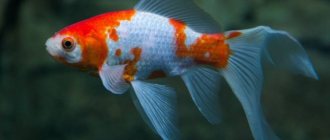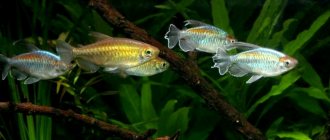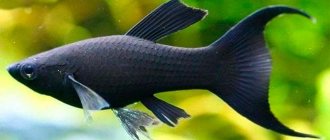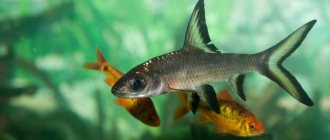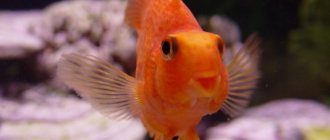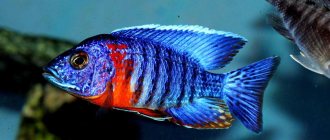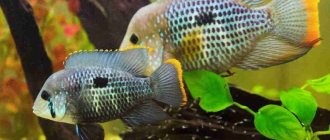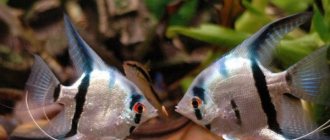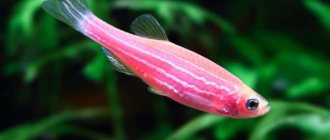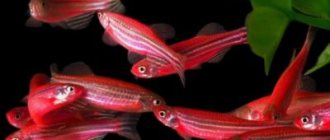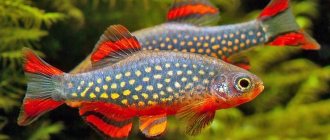Danio fish description and photo
If we talk about Danio in the context of decorative aquariums, then here the fish is favored by its richness of colors, peaceful disposition and ability to enliven the atmosphere in the aquarium. A bright flock of 7 or more individuals will fit perfectly into an aquarium with equally peaceful kids. Shimmering with multicolor, constantly playing in the upper layer of water, and in the case of GloFish, literally glowing with enthusiasm - Danio is an excellent choice for revitalizing and filling a beginner’s aquarium.
Table of basic parameters of maintenance, care and nutrition:
| What should be the volume of an aquarium for Danio? | from 30-50 liters for a school and from 120 liters for Malabar Danio |
| What should be the temperature in the aquarium for Danio? | from +20-26 °C |
| What pH should be in the aquarium? | from 6.5-7.5 pH |
| What should be the hardness of the water in the aquarium? | from 5-18° dH |
| What should be the substrate for an aquarium? | any |
| What kind of lighting should be in the aquarium? | 0.5-0.8 Watt/l daylight for at least 12 hours |
| What should be the movement of water in the aquarium? | moderate |
| Maximum fish size | up to 6 cm, Malabar Danio up to 12 cm |
| What does aquarium fish eat? | dry food, daphnia, tubifex, bloodworms |
| Type of aquarium fish | non-aggressive |
| Who is compatible with in an aquarium? | get along with small non-aggressive fish species; not compatible with shrimp |
| Lifespan of Danio | from 3-5 years, depending on the size of the individual |
Social fish
Exactly.
Fish of this species tend to lead a schooling lifestyle. They desperately need the company of members of their own species, since one zebrafish in the aquarium feels unprotected. For this reason, you should always make some kind of wholesale purchase of fish of this species. That is, take several individuals at once, preferably including 8-10 fish.
Thus, a small school will be formed, something like a family, where the fish will immediately establish their own way of life and intraspecific hierarchy, and this will become the key to order and well-being within such an aquarium social unit.
Danio care and maintenance at home
Danios are not very demanding to care for, and are therefore recommended for beginners. It is enough to choose an aquarium that meets the optimal requirements for water and light. Periodically replace the water in it with settled water. And of course, don’t forget to feed, but don’t overfeed. Reproduction of Danios in captivity is simple and fast, which is why they are also loved in the scientific community as experimental specimens.
A little about the zebrafish themselves
The genus Danio belongs to the carp fish family. This can be confirmed by the presence of small antennae located on the sides of the fish’s mouth, which is a kind of calling card for all representatives of this noble fish family.
This is a very small fish, usually not exceeding 5-6 cm in length in aquarium conditions. The zebrafish has a thin body, slightly flattened on the sides. And the hallmark of the zebrafish itself, of course, should be considered its striped coloring.
The body of the fish itself has a yellow color of different shades, but the dark stripes in most varieties of zebrafish are located strictly horizontally and run from the head to the very caudal fin.
In the wild, these fish live in the calm, slow waters of rivers and reservoirs in Southeast Asia. Such large and significant rivers as the Ganges, Mekong, and their tributaries are home to these wonderful aquarium inhabitants.
In general, zebrafish are really very easy to care for and undemanding to the conditions of keeping in an aquarium. They are practically omnivores, can easily tolerate changes in temperature and acidic water parameters, are very friendly to their neighbors and do not have an increased tendency to certain diseases.
At the same time, even such “Spartans” have their own specific requirements, subject to which a responsible aquarist will be able to significantly improve the quality and life expectancy of his striped pets.
What to feed Danio
Danios are unpretentious in food, but still it is worth making a bias towards floating food. Daphnia and bloodworms are very good options. When choosing between dry and live/frozen food, the latter will be preferable due to its positive effect on the color of pets (this essentially applies to most types of aquarium fish). However, today, among the dry food from popular manufacturers, flakes have already appeared, designed specifically to enhance the natural color. Good results are obtained: tetra pro color, tetra rubin, tetra fill, sera red parrot.
Life hack: simple dry food soaked in carrot juice also gives good color results).
You need to feed twice a day, in fractional portions, removing the remains of uneaten food.
Popular Danio Species
There are several species of Danio that are most popular among aquarists:
Danio rerio photo
The most common subspecies. Grows up to 7 cm. The color is silver, with blue stripes. It is from Danio rerio that the genetically modified variety GloFish was bred.
Danio malabar photo
The average size is 10 cm. Individuals 12-15 cm are often found. The color is silver, has a greenish line along the body, with lemon splashes. Unlike other representatives of Danio, it requires an aquarium with a volume of 120 liters or more.
Spot Zebrafish
Size from 4 to 5 cm. It has a white-golden color with an olive back and black stripes crossing the body. Below the stripes, the body is dotted with black dots, which influenced the name.
Content Features
Many generations of Danio live and breed in the artificial environment of aquariums for decades. During this time, they successfully adapted to a different habitat than that in which their wild relatives live. They are considered one of the easiest fish to keep. They prefer warm, soft, slightly acidic water. The design should include free spaces for swimming. These are perhaps the only points that you should pay attention to. They accept most popular foods and can adapt to a diet consisting entirely of dry foods (flakes, granules).
How to distinguish a female from a male Danio Breeding and reproduction of zebrafish How to care for eggs and fry of zebrafish
Bengal Danio
The Bengal Danio, scientific name Devario devario, belongs to the family Cyprinidae
Giant Danio
Giant Danio or Danio malabar, scientific name Devario aequipinnatus, belongs to the family Cyprinidae
Danio Kerry
Danio Kerry, scientific name Danio kerri, belongs to the family Cyprinidae
Danio Rerio
Danio rerio, scientific name Danio rerio, belongs to the family Cyprinidae
Danio Rerio (albino)
Albino danio rerio, scientific name Danio rerio, belongs to the family Cyprinidae
Danio Khopra
Danio choprae, scientific name Danio choprae, belongs to the family Cyprinidae
Pearl Danio
Pearl Danio, scientific name Danio albolineatus, belongs to the family Cyprinidae
Golden Danio
Golden Danio, scientific name Danio rerio, belongs to the family Cyprinidae
Leopard Danio
Leopard Danio, scientific name Danio rerio, belongs to the family Cyprinidae
Spotted Danio
Spotted Danio, scientific name Danio nigrofasciatus, belongs to the family Cyprinidae
Blue Danio
Blue Danio, scientific name Danio rerio, belongs to the family Cyprinidae
Danio panther
The panther danio, scientific name Danio aesculapii, belongs to the family Cyprinidae (Cyprinidae)
Danio Yoma
Danio Figradei or Danio Yoma, scientific name Danio feegradei, belongs to the family Cyprinidae (Cyprinidae)
Whiskered Danio
Dangila Danio or Whiskered Danio, scientific name Danio dangila, belongs to the family Cyprinidae (Cyprinidae)
Orange Danio
Orange Danio or orange-finned Danio, scientific name Danio kyathit, belongs to the family Cyprinidae (Cyprinidae)
Malabar Danio
Malabar Danio, scientific name Devario malabaricus, belongs to the family Cyprinidae
Pink Danio
Pink Danio, scientific name Danio roseus, belongs to the family Cyprinidae (Cyprinidae)
Danio royal
The king danio, scientific name Devario regina, belongs to the family Cyprinidae
Danio Inle
Danio Inle, scientific name Devario auropurpureus, belongs to the family Cyprinidae (Cyprinidae)
Danio Galaxy
Danio margaritatus, Microrasbora Galaxy or Danio Galaxy, scientific name Danio margaritatus, belongs to the family Cyprinidae
Emerald Danio
Emerald Danio, Microrasbora emerald or Microrasbora erythromicron scientific name Danio erythromicron, belongs to the family Cyprinidae
Microrasbora rubescens
Microrasbora rubescens or Red Dwarf Rasbora, scientific name Microrasbora rubescens, belongs to the family Cyprinidae
Danio Hikari
Danio Hikari, scientific name Danio sp. "Hikari", belongs to the family Cyprinidae
Danio Tivinini
Danio Tinwini, Golden Ring Danio or Spotted Burmese Danio, scientific name Danio tinwini, belongs to the family Cyprinidae
Danio the Secretive
The Secretive Danio, scientific name Danio absconditus, belongs to the family Cyprinidae
Danio Dracula
Danio Dracula, scientific name Danionella dracula, belongs to the family Cyprinidae
Danio Jaintia
Jaintia Danio, scientific name Danio jaintianensis, belongs to the family Cyprinidae
Danio Devario Sondhi
Danio Devario Sondhii, scientific name Devario sondhii, belongs to the family Cyprinidae (Cyprinidae)
Danio Gates
Gates' danio, scientific name Microdevario gatesi, belongs to the family Cyprinidae
Ceylon Danio
Danio Pathirana or Ceylon Danio, also applicable Ceylon Tiger Danio, scientific name Devario pathirana, belongs to the family Cyprinidae
Microdisassembly kubotai
Microrasbora kubotai, scientific name Microdevario kubotai, belongs to the family Cyprinidae
Dwarf Danio
The green dwarf danio, scientific name Microdevario nana, belongs to the family Cyprinidae (Cyprinidae)
What kind of aquarium is needed for zebrafish?
The habitat, if we are not talking about the Malabar giant, is an elongated aquarium from 30 to 50 liters. For all other species of Danio, a small aquarium of 10 liters or more is suitable. Considering the general mobility of Danio, it is worth equipping such an aquarium with a lid to avoid jumping out.
Danio has no special requirements for soil fillings and this applies to all varieties. Stones, sand, and artificial types of soil are suitable. The only thing that should be done is to pre-sterilize the soil by calcination or boiling.
If the aquarium is planned to be planted with living plants, for example, various types of sagittaria, Vallisneria nana, Vindelova fern and many others. It is better to select the soil not for Danio, but for specific types of plants. The fact that bright, saturated colors look great in an aquarium with Danios also speaks in favor of living plants. The same GloFish with their florescent colors, briskly flying over the emerald forest, create the atmosphere of a completely different world, a wild and uninhabited planet from a science fiction film.
Plants that are perfect for:
- glossostigma;
- sitnyag;
- marsilia quatrefoil;
- saggitaria;
- Java moss.
Java moss, a favorite among aquatic designers, can also be placed along walls or driftwood - it will look very beautiful and will not interfere with Danio playing near the surface.
Water for an aquarium with Danios must meet the following characteristics:
- temperature from +20-26°C;
- hardness from 5-18° dH;
- acidity from 6.5-7.5 pH;
- Regular water renewal (up to 30% weekly) should help maintain these parameters optimal.
Living in flowing reservoirs, Danios are demanding on water quality, cleanliness and high oxygen saturation. You should select a filter and compressor that are suitable in terms of power. It is better to set the current level to moderate. It is also necessary to install bright lighting at a rate of 0.5-0.8 Watt/l.
Soil, plants and decorations inside the aquarium
It is advisable to choose a dark shade of soil.
For bottom laying, ordinary river sand or gravel is quite suitable, the main thing is not to forget to thoroughly rinse everything with boiling water to ensure sterility. As greenery for our aquarium, we choose long-leaved types of algae. Sagittaria, Vallisneria or Heleocharis are suitable. They should be placed closer to the walls of the tank, thus leaving space for our fish.
You can use both artificial equipment and small driftwood and pebbles as decorations.
The main thing is that they are not high and do not block the middle and, especially, the upper layers of the aquarium. Fish need places to hide, but they should not interfere with a school of zebrafish moving freely around the aquarium.
Who do zebrafish get along with?
Being a peace-loving fish, Danio gets along well with most small and non-aggressive fish: Guppies, Neons, Platies, Mollies, Swordtails, Norman's Blueeyes, rainbow fish and others. However, you should not add him to larger fish, which Danio can easily become a victim of.
Separately, it is worth noting the undesirability of keeping Danio together with aquarium shrimp, the young of which are a delicacy for Danio.
Lifespan of an aquarium fish Danio
The lifespan of Danio is from 3 to 5 years, depending on the size of the individual. Larger individuals measuring 10 cm or more live longer.
Choosing neighbors for peaceful zebrafish
Very friendly fish, zebrafish will not have conflicts with any of the other aquarium inhabitants, at least on their part. Danger for zebrafish can come from predatory and simply larger aggressive fish species, which are characterized by external competitiveness.
Zebrafish get along well with species such as neons, cardinals, guppies, swordtails, mollies, speckled catfish, and many other small and non-aggressive fish.
Your aquarium will look especially wonderful if you add a flock of neons along with the zebrafish. These fish have similar habits and are equally good-natured, and their mutual flickering will turn the aquarium into a real LED disco ball.
But with fish such as eels, brocade carps, cichlids (especially astronotus) and especially piranhas, placing small defenseless zebrafish in the same aquarium would be criminally frivolous. All these fish are much larger, and they are also predators that will accept smaller fish as food.
Reproduction in a community aquarium
Danio reaches sexual maturity at 5 months. Spawning of these fish is not difficult. It also happens well in a general aquarium, without outside stimulation. Spawning begins with vigorous courtship. Brightly colored males begin to intensively pursue females. Then spawning begins. The effectiveness of this event depends directly on the number of plants in the aquarium - unprotected eggs are easily eaten by the inhabitants. The ripening of caviar lasts 3-4 days. Next, it is still better to transplant the fry without releasing them into the general aquarium until they grow up.
How long do they live and what does it depend on?
The lifespan of Danios depends on the species, but on average they live for about 3-4 years. To increase the lifespan of fish, it is recommended to observe the following conditions:
- provide regular varied feeding;
- monitor the purity and parameters of the water, saturate it with oxygen;
- take care of good lighting and arrangement of the aquarium;
- choose only peaceful, proportionate species as neighbors.
If you approach keeping Danios responsibly, they can live up to 4.5-5 years.
Types of diseases
With proper care, zebrafish rarely get sick. However, various infections can be introduced: by introducing fish that have not been quarantined, or by adding non-sterile soil.
Plistophora zebrafish
Loss of appetite. The presence of white spots on the body. Disheveled fins. Shiver. Removal of severely affected individuals. Disinfection of the aquarium. Adding methylene blue or erythrocycline to the feed.
Trichodinosis in fish
Grayish coating on the body. Reduced color brightness. Friction on hard surfaces. Increasing the water temperature (+30-+31 °C is suitable). Add salt to the water (1 tablespoon of salt per 10 liters of water) for a month.
Danio's bulging eyes
Swelling of the abdomen and eyes of the fish. The inside of the eyes fills with whitish fluid. Testing water for compliance with requirements. Increasing the number of water changes to a twice-daily frequency.
